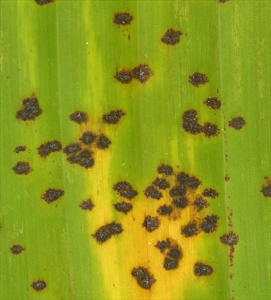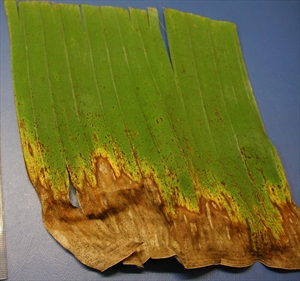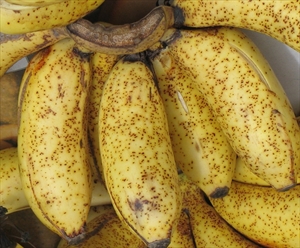Banana freckle
Pacific Pests, Pathogens, Weeds & Pesticides - Online edition
Pacific Pests, Pathogens, Weeds & Pesticides
Banana freckle (124)
Previously, freckle was Phyllosticta musarum and its sexual form, Guignardia musae; now four species are recognised: Phyllosticta cavendishii, Phyllosticta musarum, Phyllosticta maculata, and Guignardia stevensii.
Asia, US (Hawaii), Oceania. Freckle was previously identified in the Pacific islands as Phyllosticta musarum (sexual state Guignardia musae). Under those names it was present in Fiji, Samoa, Tonga and Solomon Islands. From a recent (molecular and morphological) study Guignardia stevensii occurs only in Hawaii, and both Phyllosticta maculata and Phyllosticta cavendishii occur in the South Pacific, but their distribution is uncertain. It appears that Phyllosticta musarum now has a narrow distribution. Also, the study and subsequent research indicates that Phyllosticta maculata is present in Australia, Malaysia, Indonesia, Papua New Guinea, the Philippines and the South Pacific islands, and Phyllosticta cavendishii occurs in Australia (eradicated in 2019), East Timor, Hawaii, India, Indonesia, Malaysia, the Philippines, Sri Lanka, Taiwan, Vietnam, and in the Pacific islands (Tonga and Micronesia).
Banana. Note, Phyllosticta cavendishii is the only species infecting Cavendish AAA bananas (although, like the other Phyllosticta species it also infects those in the AAB and ABB groups).
Individual reddish-brown spots occur, 0.5-1 mm diameter, later turning dark brown to black, usually on the upper surface of leaves (Photos 1&2). They occasionally form dense groups. The spots contain sac-like structures, which contain spores of the fungus. They protrude from the leaf surface and feel rough to the touch, like sandpaper. If there are large numbers of spots, the leaves turn yellow and die early (Photos 3&4). Black spots develop on green fruit and fruit stalks (Photo 5). They may completely cover the fruit by the time of harvest.
Spores of the fungus are spread short distances in wind and rain. The fungus is spread over large distances with the movement of infected fruit, leaves and suckers used for planting. It is thought that the fungus survives in diseased leaves, although it is not known for how long.
Freckle is a fungal disease that affects the fruit as well as the leaves. It can be a serious disease as the fungus infects at any stage of growth, and becomes more serious over time. On the fruit, the fungus only invades as far as the skin, but it makes the fruit unsightly and affects its market acceptability.
In Taiwan and Sri Lanka, where the Cavendish-infecting strain occurs, freckle is more important than black Sigatoka (see Fact Sheet no. 002); here, it causes premature death of the leaves, and reduces yield significantly. In the Philippines, it is second to black Sigatoka in importance.
Look for the slightly raised 'rough' spores masses associated with blackish-brown streaks, especially on the underside of the leaves. Look for smaller rough spots on the fruit.
QUARANTINE
The four species recently identified by morphological and molecular means have very different distributions, so there is need for care to prevent further spread of these fungi. It should also be noted that the Cavendish species (Phyllosticta cavendishii) was recorded in the Northern Territory of Australia in 2013, whereas previously only Phyllosticta maculata was known from there and in Queensland. However, in February 2019, the Australian Government announced that banana freckle (Phyllosticta cavendishii) had been eradicated successfully from the Northern Territory after a 5-year program, and the country was now free of the disease.
Therefore, transfers of varieties between countries should follow the FAO/IBPGR Technical Guidelines for the Safe Movement of Germplasm. No. 15. Musa. 2nd Edition, (http://www.bioversityinternational.org/uploads/tx_news/Musa_spp.__2nd_edition__502.pdf). These state that germplasm should be transferred as virus-indexed plantlets growing in a sterile tissue culture medium.
CULTURAL CONTROL
Control would only be worthwhile if Phyllosticta cavendishii was present and Cavendish AAA bananas were grown commercially (as in Taiwan), or the commercial interest was in cooking banana or plantains (i.e., ABB and ABB varieties), in which case do the following:
- Bag bunches as soon as possible after the male bud has been removed to help prevent fruit infection.
- Cut out diseased patches on leaves.
RESISTANT VARIETES
Cavendish varieties have resistance to the disease caused by Phyllosticta maculata and Phyllosticta musarum.
CHEMICAL CONTROL
In most countries in the Pacific, spraying would only be considered for Cavendish bananas, cooking varieties or plantains grown commercially. In such cases, the fungicides used against black Sigatoka would most likely provide control (see Fact Sheet no. 02). In commercial plantations, the main types of fungicides used are:
Protectant fungicides:
- Dithiocarbamates (e.g., mancozeb).
- Banana misting oil.
Systemic fungicides:
- Triazoles (e.g., propiconazole and flusilazole).
- Strobilurins (e.g., azoxystrobin).
It is important to rotate the fungicides in the different groups to prevent the build-up of resistant strains of the fungus. In drier times, mancozeb can be used alone.
____________________
When using a pesticide, always wear protective clothing and follow the instructions on the product label, such as dosage, timing of application, and pre-harvest interval. Recommendations will vary with the crop and system of cultivation. Expert advice on the most appropriate pesticides to use should always be sought from local agricultural authorities.
AUTHOR Grahame Jackson
1A way of classifying banana depending on the number of chromosomes and the ratio of the parents Musa accuminata and Musa balbisiana. Information from (including Photo 1) Gerlach WWP (1988) Plant diseases of Western Samoa. Samoan German Crop Protection Project, Deutsche Gesellschaft für Technische Zusammenarbeit (GTZ) Gmbh, Germany); and Banana freckle (2019) Business Queensland. Queensland Government. (https://www.business.qld.gov.au/industries/farms-fishing-forestry/agriculture/crop-growing/priority-pest-disease/banana-freckle); and from Banana freckle (2020) Department of Industry, Tourism and Trade. (https://nt.gov.au/industry/agriculture/food-crops-plants-and-quarantine/banana-freckle); and from Plant Health Australia (undated) Bananas freckle (Cavendish strain). Fact Sheet. (https://www.planthealthaustralia.com.au/wp-content/uploads/2015/03/Banana-freckle-FS.pdf). Photos 2,3&5 Diseases of fruit crops in Australia (2009). Editors, Tony Cooke, et al. CSIRO Publishing. Photo 4 Jacquie (Wright) Kami, formerly Plant Pathologist, Secretariat of the Pacific Community, Suva, Fiji.
Produced with support from the Australian Centre for International Agricultural Research under project PC/2010/090: Strengthening integrated crop management research in the Pacific Islands in support of sustainable intensification of high-value crop production, implemented by the University of Queensland and the Secretariat of the Pacific Community.








